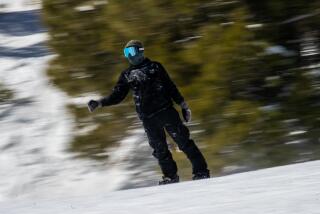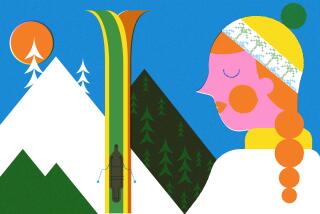Savoring a Beautiful Ski Spree Down the Slippery Slopes of Killington
- Share via
KILLINGTON, Vt. — A stiff breeze whipped across the summit. Swirls of drifting snow sprayed us as we slipped off the chair lift and edged to one side to tighten boots, adjust goggles, pull hats down snugly to keep out the chill and shove mittened hands into ski pole handles.
In the clean air we could see far to the north, across an ocean of rolling, forested mountain peaks, the blue-grey mist of distant Canada.
“Hey, let’s go,” my partner said. “It’s cold up here.”
“Right.” I pushed off, edging into a quick turn, my skis biting cleanly through a light, snow-dusted crust. “Let’s try Bear Mountain.”
“It’ll be nothing but ice.”
“It’ll be OK,” I shouted. “Follow me.”
My friend’s concern over the conditions as we started on our first run of the day would have been justified almost anywhere else, considering the fickle mid-January weather of the previous few days.
But this was Killington. And he was on his first visit.
Three days earlier, our holiday had been threatened. A soggy warm front had crawled over central Vermont, pushing up temperatures and dumping a couple of inches of rain. Right behind came a wild arctic blast, tumbling temperatures into the frigid teens.
What had been a major ski area alive with several thousand skiers enjoying a two- to four-foot snow base had turned into a model of potential icy disaster.
Then Killington did what it has become legendary at doing--converting near-disaster into good skiing. Even as the temperature plunged, a fleet of more than a dozen huge snow cats charged the slopes.
Hour after hour through the long, cold night, their headlights piercingly bright in the blackness, they chewed up the icy crud and spat it back as crunchy powder. Then, on mile after mile of trail, the snow guns created instant mini-blizzards.
Now we were enjoying the payoff as we skied over to the Bear Mountain complex of expert runs. When we reached the top of the football-field-wide slopes of the black diamond Outer Limits, my friend was ecstatic.
“Hey, yesterday this was all ice,” he said. “Look at it now.”
With an exuberant shout, he leaped off the summit, hurtling down the steep pitch. I followed at a much more conservative pace. I stopped to admire the snow. I stopped to examine the trees. I stopped to contemplate the architecture of the Bear Mountain base lodge, tiny in the distance. And I stopped to question why I still was attempting such ferocious white cliffs.
The ability to “keep ‘em skiing” helps explain why Killington has edged into the front ranks of America’s dozen or so truly great destination resorts in the past decade.
Today it boasts 77 miles of trail, 18 lifts, including five high-speed quads, and the longest ski gondola--3 1/2 miles--in North America.
Trails wind down from six mountains--Rams Head, Snowdon, Killington Peak (the highest of the lot with an elevation of 4,241 feet), Skye Peak, Bear Mountain and Sunrise Mountain. All the mountains are linked by trails.
The resort has a vertical rise of 3,100 feet. This compares with the vertical rise of such popular Western playgrounds as Sun Valley (3,400 feet), Vail (3,250 feet), Mammoth (3,100 feet) and Squaw Valley (2,850 feet).
The terrain is remarkably varied. Ski magazine recently rated the nation’s major resorts for “terrain extent.” Killington was No. 3, behind only Mammoth and Vail.
First there is Snowshed, a billiard table of a slope, three-quarters of a mile long and a quarter-mile wide. It’s the perfect learner’s slope, especially since it’s in a location not popular with the “whiz-past-’em” set.
And there is Juggernaut. This is an awesome run that ambles gently through the woods for 10 miles, from the top of Killington Peak to the foot of Northeast Passage. It is even more popular with cross-country skiers out for a long glide than with cautious alpine skiers.
At the other extreme are some 40 black diamond trails, with the most ferocious largely clustered at Bear Mountain and Skye Peak.
Killington’s trails are wide, well groomed and stay close to the fall line. But there is an exception. If you want to know what it was like in the early ‘30s when grandma and grandpa rode the ski trains to the infant New England resorts, try the nasty Roundabout.
As you hop, twist and curve your way down, just remember: Grandma and grandpa did it wearing seven-foot wooden slabs locked onto their leather boots with bearpaw bindings.
Killington is smothered with an annual average winter snowfall of 240 inches. But winters being somewhat less than entirely dependable, Killington also covers 40 miles of its trails with what it claims is the largest snow-making capacity in the world.
Killington has lots of smarts, too.
For example, it impresses on chair operators the basic need to keep the lifts moving. If someone slips getting on, a lift is stopped only for safety reasons.
On an unusually cold New England day, cashiers handed out free cloth face masks with the tickets they sold.
The children’s center in the Snowshed base lodge will admit babies still in diapers. At age 3, on-the-hill ski lessons begin. It’s a charming sight watching a gaggle of tots, like overstuffed dolls in their ski suits, lugging tiny skis to the top of a 50-foot hill.
Kids 8 to 12 have their own special classes, which range from those for beginners to mogul runs for young black diamond experts, as well as instruction in the techniques of downhill racing.
Killington pushes hard to capitalize on the publicity of being the first Eastern resort to open in the fall, and the last to close each spring. Thanks to its snowmaking, the resort has opened its highest runs in October and kept them open until late May or early June for most of the past 15 years.
-- -- --
Killington has an abundance of facilities. Five base lodges contain five cafeterias. They serve the usual mediocre and predictable cuisine found at virtually all American resorts, from dull soups and skimpy burgers and French fries to boring chili.
However, the food in the charming, full-service restaurant in the Snowshed base lodge, Pogonips, is much better.
But why be concerned about the quality of the potables and edibles when sitting in the gleaming restaurant atop Killington Peak? The view is breathtaking. The summit cafe is reached via the long and scenic ride in the four-man gondola cars, or the Killington chair.
Killington’s apres -ski life flourishes all over the Vermont countryside. A number of cheerful nightspots, bars and restaurants are scattered along the busy access road that links Killington with U.S. 4 about five miles away.
The longtime local leader of the apres -ski pack is the Wobbly Barn. It serves excellent prime steaks broiled over mesquite on one floor, and hosts the most crowded dance floor in the region on another.
Other popular stops on the access road include the Pickel Barrel, with continuous entertainment and dancing; Charity’s 1887 Saloon, noted for its barbecue and Mexican foods, and Casey’s Caboose, where you’ll sit in turn-of-the-century railroad cars to dine on Maine lobster. Annabelle’s restaurant is in a 200-year-old farmhouse in nearby Stockbridge. Its continental cuisine is superb, and the wine list is one of the region’s most extensive.
For those willing to drive about 25 miles to Rutland, the Ritz brags about its cocktails and the fact that it’s the first video club around. Near the access road, on U.S. 4, is Hemingway’s, a superb restaurant. The Mobil Guide considers it worth a special trip. So do I.
Some 20,000 beds are available in the Killington area. They range from trail-side luxury condominiums to inexpensive motels scattered along the highway. There are old country inns, chalets, lodges and hotels, as well as several “building houses” that cater to families and serve meals in communal dining rooms. The menus haven’t changed much in the past 100 years; it’s still simple country cooking.
Packages of three, five and seven nights, or longer, with or without meals, with unlimited use of lifts and with or without lessons and/or rentals, can be arranged by calling the ski resort’s Lodging Bureau at (802) 773-1330, or by writing for what may be the most complete housing directory published by a ski resort anywhere: Killington Lodging Bureau, 203 Killington Road, Killington, Vt. 05751.
Within walking distance of the slopes, luxury lodge facilities and condos range from $287 per person double occupancy for three nights to $432 double.
Smaller hotels, chateaus and inns are approximately $75 and up.
Motel accommodations are generally in the $50-to-$100 range.
For nonskiers, or those who want a break from the glories of the mountains, there’s much to see and do in the Killington area. Activities include horse-drawn sleigh rides, tobogganing, snowshoe treks, bowling, ice skating, swimming, movies, health spas and, in the early spring, heading into the maple woods to watch local farmers “sugaring off,” the deliciously tasty task of making maple syrup in steaming vats.
More to Read
Sign up for The Wild
We’ll help you find the best places to hike, bike and run, as well as the perfect silent spots for meditation and yoga.
You may occasionally receive promotional content from the Los Angeles Times.






